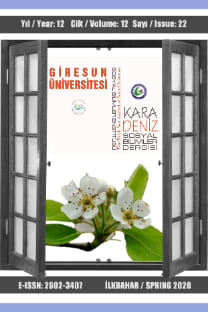İlköğretim Öğrencilerinde Proje Tabanlı Mikroskobik Canlı Bilincinin Oluşturulması
İlköğretim öğrencileri, mikroorganizma, proje, analiz
Creating Project-Based Microscopic Live Consciousness in Elementary Students
Elementary school students, microorganism, project, analysis,
___
- Abad, M. J., Bedoya, L. M., & Bermejo, P. (2011). Marine Compounds and their Antimicrobial Activities. In A. Méndez-Vilas (Ed.), Science Against Microbial Pathogens: Communicating Current Research and Technological Advances (pp. 1293-1306). Badajoz: Formatex Research Center.
- Akay, C. (2013). Ortaokul Öğrencilerinin Yaparak-Yaşayarak ÖğrenmeTemelli TÜBİTAK 4004 Bilim Okulu Projesi Sonrası Bilim Kavramına Yönelik Görüşleri. Mersin Üniversitesi Eğitim Fakültesi Dergisi, 9(2), 326-338.
- Aktamış, H. ve Ergin, Ö. (2006). Fen eğitimi ve yaratıcılık. Dokuz Eylül Üniversitesi Buca Eğitim Fakültesi Dergisi, 20, 77-83.
- Alkış, S. (2007). İlköğretim beşinci sınıf öğrencilerinin yağış çeşitlerini ve oluşumlarını algılama biçimleri. Eurasian Journal of Educational Research, 26, 27-38.
- Altuğ, G., Yardımcı, C. H. ve Onaç-İçöz, I. (2005). Haliç yüzey sularında enterobacteriaceae üyelerinin bazı beta-laktam antibiyotiklerine dirençlilik frekansı. Türk Sucul Yaşam Dergisi, 3(4), 258-264.
- Avcı, E., Özenir, Ö. S., Kurt, M. ve Atik, S. (2015). TÜBĐTAK 4004 Doğa Eğitimi ve Bilim Okulları Kapsamında Ortaokul Öğrencilerine Yönelik Gerçekleştirilen “Bizim Deniz Akdeniz” Projesinin Değerlendirilmesi. Amasya Üniversitesi Eğitim Fakültesi Dergisi, 4(2), 312-333.
- Aydede, M. N. ve Matyar, F. (2009). Fen bilgisi Öğretiminde Aktif Öğrenme Yaklaşımının Bilişsel Düzeyde Öğrenci Başarısına Etkisi Türk Fen Eğitimi Dergisi, 6(1), 115-127.
- Blair, J. M. A., Webber, M. A., Baylay, A. J., Ogbolu, D. O., & Piddock, L. J. V. (2015). Molecular mechanisms of antibiotic resistance. Nat Rev Micro, 13(1), 42-51. doi: 10.1038/nrmicro3380
- Bloom, B. S. (1956). Taxonomy of Educational Objectives: The Classification of Educational Goals. (Vol. Handbook I: Cognitive Domain). New York: D. McKay.
- Cavanagh, S. (2007). Science Camp: Just for the Girls. Education Week, 26(45), 26-28. http://www.edweek.org/ew/articles/2007/08/15/45girls.h26.html?print=1
- Eş, H. ve Sarıkaya, M. (2010). İlköğretim 6. Sınıf Fen ve Teknoloji Dersi “Yaşamımızdaki Elektrik” Ünitesinde Öğrenci Başarılarının İncelenmesi. Yüzüncü Yıl Üniversitesi Eğitim Fakültesi Dergisi, 7(1), 107-127.
- Field, A. (2009). Discovering Statistics using IBM SPSS Statistics (3 ed.). Thousand Oaks, California: SAGE Publications.
- Jones, M. G., & Rua, M. J. (2006). Conceptions of Germs: Expert to Novice Understandings of Microorganisms. Electronic Journal of Science Education, 10(3).
- Karasar, N. (2012). Bilimsel Araştırma Yöntemi (24 ed.). Ankara: Nobel Yayın Dağıtım.
- Koerner, C. (2016). Dreaded Antibiotic-Resistant Bacteria Found In U.S. For First Time. https://www.buzzfeed.com/claudiakoerner/antibiotic-resistant-bacteria-found-inus? utm_term=.lbLKeKRO6#.lw9929LRq sitesinden 01.02.2017 tarihinde alındı.
- Leech, N. L., Barrett, K. C., & Morgan, G. A. (2005). SPSS for Intermediate Statistics: Use and Interpretation (2 ed.). Mahwah, New Jersey: Lawrence Erlbaum.
- Matyar, F. (2008). Fen ve Teknoloji Öğretiminde Proje ve Araştırma Tabanlı Öğrenme. In Ö. Taşkın (Ed.), Fen ve teknoloji öğretiminde yeni yaklaşımlar (pp. 23-39). Ankara: Pegem Akademi Yayıncılık.
- Mutlu, M. ve Tokcan, H. (2012). İlköğretim 7. sınıf öğrencilerinin toprak kirliliği hakkındaki düşünceleri. International Journal Of Social Science Research, 1(1), 65-75.
- Ouyang, Y., & Hayden, K. (2010). A technology infused science summer camp to prepare student leaders in 8th grade classrooms. Paper presented at the Proceedings of the 41st ACM technical symposium on Computer science education, SIGCSE, Milwaukee, Wisconsin, USA. http://dblp.unitrier. de/db/conf/sigcse/sigcse2010.html#OuyangH10
- Polat, M., Şendur, G. ve Şenay, M. A. (2013). Kentsel ve Kırsal Bölgede Öğrenim Gören Öğrencilerin FENdeposu Eğitim Portalına İlişkin Görüşlerinin Değerlendirilmesi. Amasya Üniversitesi Eğitim Fakültesi Dergisi, 2(2), 370-392.
- Saracaloğlu, S., Akamca, G. Ö. ve Yeşildere, S. (2013). İlköğretimde proje tabanlı öğrenmenin yeri. Türk Eğitim Bilimleri Dergisi, 4(3), 241-258.
- Şimşek, C. L. (2011). Okul dışı öğrenme ortamları ve fen eğitimi. In C. L. Şimşek (Ed.), Fen öğretiminde okul dışı öğrenme ortamları. Ankara: Pegem Akademi.
- Uğraş, S., Ültay, N., Ültay, E., Dursun, H., Ülger, S., Üzmez, Ş. ve Kaya, E. (2015). Mikrodünyaya Yolculuk Projesinin Katılımcı Öğrencilerin Bilimsel Düşünme Becerilerine ve Davranışlarına Etkisi. The Journal of International Social Research, 8(41), 1039-1045.
- WHO. (2014). Antimicrobial resistance: global report on surveillance 2014 (pp. 257): World Health Organization.
- ISSN: 2602-3407
- Yayın Aralığı: 2
- Başlangıç: 2009
- Yayıncı: -
KADİR CANER DOĞAN, HASAN MAHMUT KALKIŞIM
Nurettin Topçu’nun “Taşralı” Adlı Eserinde Dini Otorite ve Din Adamı
ESRA KARABAĞ KÖSE, NEZAHAT GÜÇLÜ
Giresun İli ve Yöresi Ağızlarında Kadın
2008 Küresel Krizi ve Değişen Para Politikaları: Dünyada ve Türkiye’de Faiz Koridoru Uygulaması
Bir Türk Subayının Raporuna Göre Mübadelenin Yunanistan’daki Yansımaları
İki Sistemli Kuram Olarak Sosyalist Feminizm
Toplumcu-Gerçekçi Bir Yazar Olan Burhan Günel’in Öykülerinde Gecekondu
Borçalılı Türklerin Yurttaşlık Kazanımları ve Tahmini Nüfus Sayıları Üzerine Bir Değerlendirme
